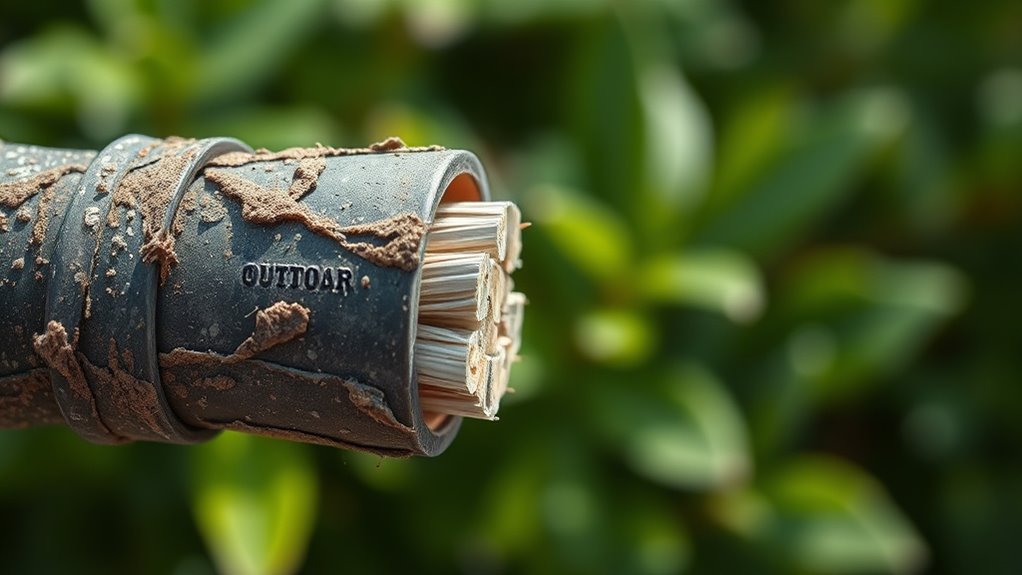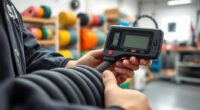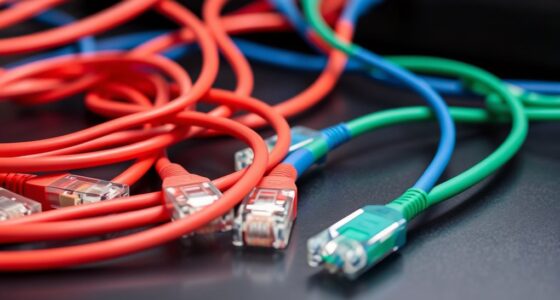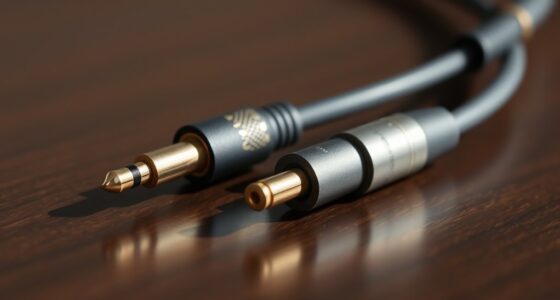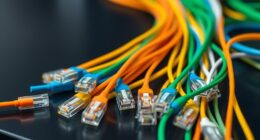For outdoor use, you’ll want cables with jackets that are UV resistant and water resistant to withstand sun exposure and moisture. Look for ratings like J or TJ, which indicate protection against UV rays and water ingress. This guarantees your cables stay flexible, durable, and safe over time. Choosing the right jacket rating helps prevent cracking, corrosion, and failures. Keep exploring to learn more about how specific ratings can protect your outdoor wiring projects.
Key Takeaways
- Outdoor cables require jackets with UV-resistant ratings to prevent degradation from sunlight exposure.
- Water-resistant jackets protect against moisture ingress, preventing corrosion and electrical failures in outdoor environments.
- Proper jacket ratings ensure flexibility, durability, and safety during long-term outdoor installation and exposure.
- Selecting cables with appropriate outdoor jacket ratings reduces maintenance costs and extends cable lifespan.
- Understanding specific ratings helps ensure compliance with safety standards and optimal performance in outdoor conditions.
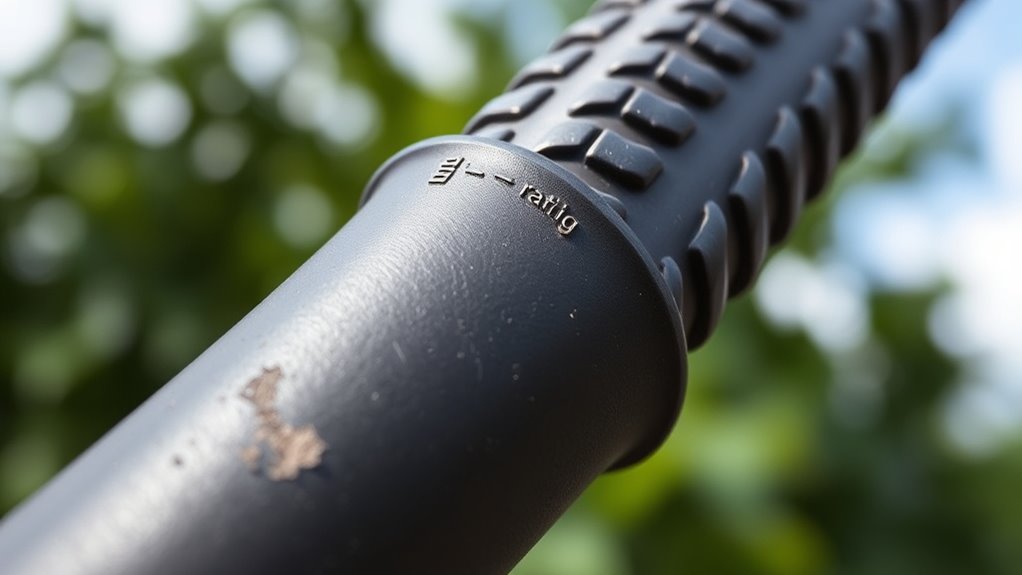
Cable jacket ratings are essential for ensuring safety, durability, and performance in various environments. When you’re working outdoors or in areas exposed to the elements, choosing the right cable jacket with appropriate ratings becomes crucial. Two key factors to consider are UV resistance and water resistance, which directly impact how well your cables perform over time.
UV resistance is vital if your cables will be exposed to sunlight for extended periods. Ultraviolet rays can degrade many materials, causing the jacket to become brittle, crack, or lose its protective qualities. When you select a cable with high UV resistance, you’re ensuring it can withstand prolonged sun exposure without deteriorating. This not only maintains the cable’s structural integrity but also preserves its safety features, preventing potential failures or hazards down the line. A UV-resistant jacket helps your cables stay flexible and durable, reducing the need for frequent replacements and minimizing maintenance costs.
UV-resistant jackets keep cables flexible and durable, preventing deterioration from prolonged sun exposure.
Water resistance is equally important, especially when cables are installed outdoors, underground, or in damp environments. Water can seep into unprotected cables, leading to electrical shorts, corrosion, and eventual failure. A water-resistant jacket creates a barrier that prevents moisture from penetrating the cable, safeguarding the internal conductors. This resistance is particularly critical during heavy rain, snow, or high humidity conditions. When you choose cables with water-resistant ratings, you’re making sure that your wiring remains reliable and safe, even in challenging climates. It also helps prevent issues like rust and corrosion, which can compromise the cable’s lifespan and performance. Additionally, understanding the specific ratings associated with cable jackets helps you make informed choices, ensuring you select a product designed to endure the environment it’s meant for, saving you time, money, and potential safety hazards.
Frequently Asked Questions
How Do UV Ratings Affect Cable Jacket Durability Outdoors?
UV ratings directly impact your cable’s outdoor durability by indicating its UV resistance. If your cable jacket has high UV resistance, it’s better protected against sun damage, which helps extend its jacket longevity. Without proper UV protection, the jacket can degrade faster, leading to cracks and exposure of internal wires. So, choose cables with strong UV ratings to guarantee your outdoor setup remains reliable and long-lasting.
Are There Specific Ratings for Extreme Weather Conditions?
Think of extreme weather conditions as nature’s ultimate test; yes, there are specific ratings for them. You’ll want cables that meet weatherproofing standards like UV resistance, moisture sealing, and corrosion resistance. These ratings guarantee the cable withstands harsh elements such as snow, rain, and intense sun. By choosing cables with these certifications, you guarantee durability and safety, even when the weather throws its worst at you.
Can Indoor-Rated Cables Be Used Outdoors Temporarily?
You can use indoor-rated cables for temporary outdoor use, but only if the exposure is limited and the conditions are mild. Keep in mind, indoor cables aren’t designed to withstand moisture, UV rays, or extreme weather, so they may degrade quickly. If you plan to leave the cable outside for an extended period, it’s safer to switch to outdoor-rated cables to guarantee safety and durability.
How Do Chemical Exposures Impact Outdoor Cable Jackets?
Imagine your outdoor cable jacket as a shield in a chemical battlefield. Chemical exposures can erode or weaken the jacket, compromising environmental protection. They diminish chemical resistance, making cables vulnerable to moisture, corrosion, and damage. If you don’t choose jackets with proper chemical resistance, outdoor conditions can quickly degrade the insulation, risking failure and safety. Always select cables rated for chemical exposure to guarantee durability and reliable performance outdoors.
What Are the Cost Differences Between Various Outdoor Jacket Ratings?
You’ll find that cost differences between outdoor jacket ratings vary based on jacket material and level of protection. Generally, higher-rated jackets like UV or sunlight-resistant ones cost more because they’re made from specialized materials that withstand harsh conditions. A cost comparison shows that standard jackets are more affordable, but investing in higher-rated options can save you money long-term by reducing maintenance and replacement needs. Consider your environment and durability requirements to choose the best value.
Conclusion
Choosing the right cable jacket rating is like selecting a suit for all seasons—durable enough to weather the storm, flexible enough to move with you. Think of outdoor cables as guardians standing firm against sun, rain, and wind, yet gentle enough to bend without breaking. With the right rating, you’re not just installing a cable; you’re planting a sturdy, resilient anchor that keeps your connection alive through every storm and sunshine alike.
